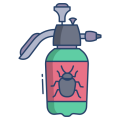Indoor Air Quality Monitoring

Indoor air quality monitoring(IAQ) can have a huge impact on health, well-being and productivity of the building occupants Whether its hospital, hotel, corporate office, schools, commercial or institutional building, poor IAQ can be hazardous to the health of workers, besides you need to fulfil the regulatory compliance. This is why it is important for you to get a pre-monitoring and testing of indoor air after construction and before moving in your workforce.
Occupational Safety and Health Administration (OSHA)recognizes that poor IAQ can be hazardous to workers’ health and it is indispensable for building owners, managers, and employers to take a proactive approach to address IAQ concerns.
The employers should keep their buildings free of pollutants or conditions that lead to poor IAQ.
Harmful impact on health of workers
• Numerous studies of OSHA show that poor Indoor Air Quality can develop respiratory symptoms, allergies,
asthma, cough, wheezing, shortness of breath, sinus congestion, sneezing, nasal congestion, and sinusitis.
• The United Nations’ Global Millennium Development Goals have advocated clean household energy and reduced
solid fuel use for lowering indoor air pollution and associated respiratory illness.
• Health impacts of indoor air pollutants range from acute to chronic respiratory diseases including lung
cancer, asthma, pneumonia, tuberculosis extending to cardiovascular diseases such as stroke.
• Combustion appliances, building products such as composite wood, paints and coatings, adhesives and
sealants, cleaning products, toner from printers, air fresheners, adhesives used in building materials,
moisture, and occupants are some of the main indoor and outdoor sources of indoor air contamination.
• IAQ indicators such as CO2 and VOCs in indoor air, and building ventilation rates have a significant
impact on employee cognitive functions, which in turn affects productivity and performance.
• Long term exposure to VOC can be toxic for human health.
Accreditations and Approvals
All follow the guidelines of WHO, Factory Act, National Ambient Air Quality System (NAAQS) for indoor /work zone air monitoring.
Equipment used for testing and monitoring of IAQ
All use a handy sampler for monitoring and sampling of Indoor air quality or work zone air quality. For PM 2.5 we use filter paper and for gaseous parameters like So2, Formaldehyde, NO2 we use absorbing solution.
Turnaround time
The Indoor Air Quality sampling takes 2-4 hours of time and it takes 3-4 days for analysis. For microbiological parameters it will take 6-7 days in analysis and 30 minutes for sampling.
A glance at standard limits, regulations and Test Methods
It is important to follow the guidelines of WHO and Factory Act. Besides OSHA and National Ambient Air Quality System (NAAQS) for limits and regulations.
Chemical Parameters
Particulate matter IS 5182(P-24) 2019 – 65 ug/m3
Nitrogen Dioxide (NO2) PPM IS 5182(P-6),1975- 5ppm
Sulphur Dioxide (SO2) PPM – IS 5182 (P-2) 2001 -5ppm
Formaldehyde PPM- APHA Air 23rd Edition -0.75 ppm
For microbiological parameters like Total Coliform, E.coli, Yeast and mold , Total Fungal count and the limits should be absent per plate.
 Admin Register
Admin Register

 Alcohol
Alcohol  Baby Care
Baby Care  Bakery, Cakes & Dairy
Bakery, Cakes & Dairy  Beauty-&-Hygiene
Beauty-&-Hygiene  Beverages
Beverages  Cleaning & Household
Cleaning & Household  Construction Materials
Construction Materials  Foodgrains, Oil & Masala
Foodgrains, Oil & Masala  Medicine
Medicine  Medicine Related Cosmetics
Medicine Related Cosmetics  Non-Veg
Non-Veg  Pesticides
Pesticides  Snacks & Branded Foods
Snacks & Branded Foods  Supplement
Supplement  Veterinary
Veterinary 